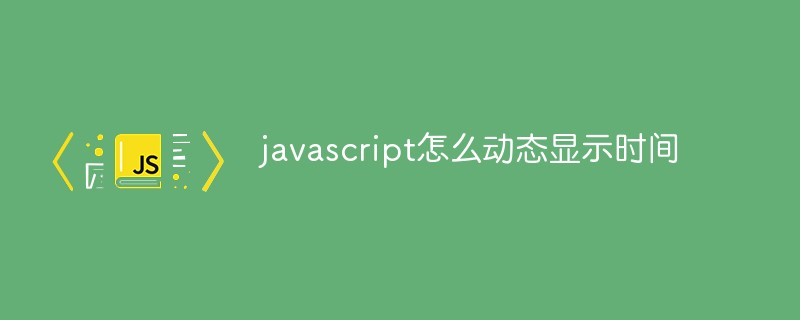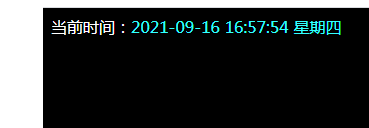How to dynamically display time in javascript
How to display time in JavaScript: 1. Use "new Date()" to define a date object; 2. Use the date object's getFullYear(), getMonth() and other methods to obtain the year, month, day, hour, minute, and second values and output them; 3. Use the setTimeout() method to refresh the time value once a second.

The operating environment of this tutorial: windows7 system, javascript version 1.8.5, Dell G3 computer.
javascript dynamic display time implementation code:
<html>
<head>
<title>网页中动态的显示系统日期时间</title>
<script language="JavaScript">
function startTime()
{
var today=new Date();//定义日期对象
var yyyy = today.getFullYear();//通过日期对象的getFullYear()方法返回年
var MM = today.getMonth()+1;//通过日期对象的getMonth()方法返回年
var dd = today.getDate();//通过日期对象的getDate()方法返回年
var hh=today.getHours();//通过日期对象的getHours方法返回小时
var mm=today.getMinutes();//通过日期对象的getMinutes方法返回分钟
var ss=today.getSeconds();//通过日期对象的getSeconds方法返回秒
// 如果分钟或小时的值小于10,则在其值前加0,比如如果时间是下午3点20分9秒的话,则显示15:20:09
MM=checkTime(MM);
dd=checkTime(dd);
mm=checkTime(mm);
ss=checkTime(ss);
var day; //用于保存星期(getDay()方法得到星期编号)
if(today.getDay()==0) day = "星期日 "
if(today.getDay()==1) day = "星期一 "
if(today.getDay()==2) day = "星期二 "
if(today.getDay()==3) day = "星期三 "
if(today.getDay()==4) day = "星期四 "
if(today.getDay()==5) day = "星期五 "
if(today.getDay()==6) day = "星期六 "
document.getElementById('nowDateTimeSpan').innerHTML=yyyy+"-"+MM +"-"+ dd +" " + hh+":"+mm+":"+ss+" " + day;
setTimeout('startTime()',1000);//每一秒中重新加载startTime()方法
}
function checkTime(i)
{
if (i<10){
i="0" + i;
}
return i;
}
</script>
</head>
<body onload="startTime()" style="background-color: #000000;color: white;">
当前时间:<font color="#33FFFF"><span id="nowDateTimeSpan"></span></font>
</body>
</html>Rendering:

Methods of the Date object
The Date object allows you to obtain the time relative to the International Standard Time (Greenwich Mean Time, now called UTC-Universal Coordinated Time) or the time the Flash player is running. Operating system time and date. To use the methods of the Date object, you must first create an instance of the Date object.
Date objects must use Flash 5 or later players.
The methods of the Date object are not static, but they can be applied to the specified individual entities when used.
Method introduction of Date object:
getDate | Get the current date (the day of the month) based on local time
getDay | Based on local time Get the day of the week today is (0-Sunday, 1-Monday…)
getFullYear | Get the current year (four digits) based on local time
getHours | Get the current number of hours based on local time ( 24-hour format, 0-23)
getMilliseconds | Get the current number of milliseconds based on local time
getMinutes | Get the current number of minutes based on local time
getMonth | Get based on local time The current month (note that it starts from 0: 0-Jan, 1-Feb...)
getSeconds | Get the current seconds based on local time
getTime | Get the UTC format from 1970.1.1 0: The number of milliseconds since 00
getTimezoneOffset | Get the offset value of the current time and UTC format (in minutes)
getUTCDate | Get the current date in UTC format (the day of the month)
getUTCDay | Get the day of the week today in UTC format (0-Sunday, 1-Monday…)
getUTCFullYear | Get the current year in UTC format (four digits)
getUTCHours | Get the current number of hours in UTC format (24-hour format, 0-23)
getUTCMilliseconds | Get the current number of milliseconds in UTC format
getUTCMinutes | Get the current number of minutes in UTC format
getUTCMonth | Get the current month in UTC format (note that it starts from 0: 0-Jan, 1-Feb...)
getUTCSeconds | Get the current seconds in UTC format
getYear | Get the current abbreviated year based on local time (current year minus 1900)
setDate | Set the current date (the day of the month)
setFullYear | Set the current year (four digits)
setHours | Set the current number of hours (24-hour format, 0-23)
setMilliseconds | Set the current number of milliseconds
setMinutes | Set the current number of minutes
setMonth | Set the current month (note starting from 0: 0-Jan, 1-Feb...)
setSeconds | Set the current seconds
setTime | Set UTC format from 1970.1.1 0: The number of milliseconds since 00
setUTCDate | Set the current date in UTC format (the day of the month)
setUTCFulYear | Set the current year in UTC format (four digits)
setUTCHours | Set the current number of hours in UTC format (24-hour format, 0-23)
setUTCMilliseconds | Set the current number of milliseconds in UTC format
setUTCMinutes | Set the current number of minutes in UTC format
setUTCMonth | Set the current month in UTC format (note that it starts from 0: 0-Jan, 1-Feb...)
setUTCSeconds | Set the current seconds in UTC format
setYear | Set the current abbreviated year (the current year minus 1900)
toString | Convert the date and time value into a string value in the form of "date/time"
Date.UTC | Return the specified UTC Fixed time value in format date and time
[Recommended learning: javascript advanced tutorial]
The above is the detailed content of How to dynamically display time in javascript. For more information, please follow other related articles on the PHP Chinese website!

Hot AI Tools

Undresser.AI Undress
AI-powered app for creating realistic nude photos

AI Clothes Remover
Online AI tool for removing clothes from photos.

Undress AI Tool
Undress images for free

Clothoff.io
AI clothes remover

Video Face Swap
Swap faces in any video effortlessly with our completely free AI face swap tool!

Hot Article

Hot Tools

Notepad++7.3.1
Easy-to-use and free code editor

SublimeText3 Chinese version
Chinese version, very easy to use

Zend Studio 13.0.1
Powerful PHP integrated development environment

Dreamweaver CS6
Visual web development tools

SublimeText3 Mac version
God-level code editing software (SublimeText3)

Hot Topics
 1392
1392
 52
52
 How to implement an online speech recognition system using WebSocket and JavaScript
Dec 17, 2023 pm 02:54 PM
How to implement an online speech recognition system using WebSocket and JavaScript
Dec 17, 2023 pm 02:54 PM
How to use WebSocket and JavaScript to implement an online speech recognition system Introduction: With the continuous development of technology, speech recognition technology has become an important part of the field of artificial intelligence. The online speech recognition system based on WebSocket and JavaScript has the characteristics of low latency, real-time and cross-platform, and has become a widely used solution. This article will introduce how to use WebSocket and JavaScript to implement an online speech recognition system.
 WebSocket and JavaScript: key technologies for implementing real-time monitoring systems
Dec 17, 2023 pm 05:30 PM
WebSocket and JavaScript: key technologies for implementing real-time monitoring systems
Dec 17, 2023 pm 05:30 PM
WebSocket and JavaScript: Key technologies for realizing real-time monitoring systems Introduction: With the rapid development of Internet technology, real-time monitoring systems have been widely used in various fields. One of the key technologies to achieve real-time monitoring is the combination of WebSocket and JavaScript. This article will introduce the application of WebSocket and JavaScript in real-time monitoring systems, give code examples, and explain their implementation principles in detail. 1. WebSocket technology
 How to use JavaScript and WebSocket to implement a real-time online ordering system
Dec 17, 2023 pm 12:09 PM
How to use JavaScript and WebSocket to implement a real-time online ordering system
Dec 17, 2023 pm 12:09 PM
Introduction to how to use JavaScript and WebSocket to implement a real-time online ordering system: With the popularity of the Internet and the advancement of technology, more and more restaurants have begun to provide online ordering services. In order to implement a real-time online ordering system, we can use JavaScript and WebSocket technology. WebSocket is a full-duplex communication protocol based on the TCP protocol, which can realize real-time two-way communication between the client and the server. In the real-time online ordering system, when the user selects dishes and places an order
 How to implement an online reservation system using WebSocket and JavaScript
Dec 17, 2023 am 09:39 AM
How to implement an online reservation system using WebSocket and JavaScript
Dec 17, 2023 am 09:39 AM
How to use WebSocket and JavaScript to implement an online reservation system. In today's digital era, more and more businesses and services need to provide online reservation functions. It is crucial to implement an efficient and real-time online reservation system. This article will introduce how to use WebSocket and JavaScript to implement an online reservation system, and provide specific code examples. 1. What is WebSocket? WebSocket is a full-duplex method on a single TCP connection.
 JavaScript and WebSocket: Building an efficient real-time weather forecasting system
Dec 17, 2023 pm 05:13 PM
JavaScript and WebSocket: Building an efficient real-time weather forecasting system
Dec 17, 2023 pm 05:13 PM
JavaScript and WebSocket: Building an efficient real-time weather forecast system Introduction: Today, the accuracy of weather forecasts is of great significance to daily life and decision-making. As technology develops, we can provide more accurate and reliable weather forecasts by obtaining weather data in real time. In this article, we will learn how to use JavaScript and WebSocket technology to build an efficient real-time weather forecast system. This article will demonstrate the implementation process through specific code examples. We
 Simple JavaScript Tutorial: How to Get HTTP Status Code
Jan 05, 2024 pm 06:08 PM
Simple JavaScript Tutorial: How to Get HTTP Status Code
Jan 05, 2024 pm 06:08 PM
JavaScript tutorial: How to get HTTP status code, specific code examples are required. Preface: In web development, data interaction with the server is often involved. When communicating with the server, we often need to obtain the returned HTTP status code to determine whether the operation is successful, and perform corresponding processing based on different status codes. This article will teach you how to use JavaScript to obtain HTTP status codes and provide some practical code examples. Using XMLHttpRequest
 How to use insertBefore in javascript
Nov 24, 2023 am 11:56 AM
How to use insertBefore in javascript
Nov 24, 2023 am 11:56 AM
Usage: In JavaScript, the insertBefore() method is used to insert a new node in the DOM tree. This method requires two parameters: the new node to be inserted and the reference node (that is, the node where the new node will be inserted).
 JavaScript and WebSocket: Building an efficient real-time image processing system
Dec 17, 2023 am 08:41 AM
JavaScript and WebSocket: Building an efficient real-time image processing system
Dec 17, 2023 am 08:41 AM
JavaScript is a programming language widely used in web development, while WebSocket is a network protocol used for real-time communication. Combining the powerful functions of the two, we can create an efficient real-time image processing system. This article will introduce how to implement this system using JavaScript and WebSocket, and provide specific code examples. First, we need to clarify the requirements and goals of the real-time image processing system. Suppose we have a camera device that can collect real-time image data




